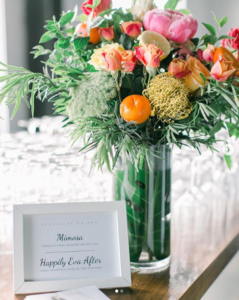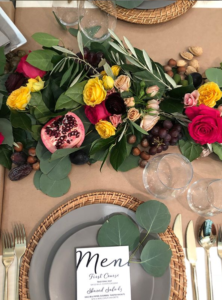How to Incorporate Fruit in Flower Arrangements
Adding something unexpected into a flower arrangement, to bring in a fresh element of color, form, or texture, is often the key to transforming the overall effect from beautifully pleasant to eye-catching and original. While there is a huge variety of flowers and foliage to choose from to achieve that goal, even if you’re sticking strictly within what’s available seasonally, you can expand your palette of materials with another type of nature’s gifts—fruits.
What kinds of fruit can be incorporated into a flower arrangement? More than you might think. Berries, vining fruits such as grapes, or even larger fruits like lemons, apples, and miniature pineapples can serve as accents or focal points. A cluster of kumquats might give you a pop of smooth orange amid green foliage, or a pomegranate nestled among lush blossoms can lend rich color to a bouquet. Here’s what you should know:
For fruits that grow on branches, stems, or vines, they’re easiest to include if you leave them attached. For example, stems of blueberries can be tucked in around your primary flowers quite easily. For larger fruits, you can create a “stem” for placement by putting them on a skewer and wrapping it in green florist’s tape, so it can be secured in the arrangement. Large and heavy fruits should be positioned in the middle, where they won’t overbalance the arrangement or topple out. You may also want to add additional support in the form of stiff floral wire to help keep them in place. Mist your arrangement with water to keep the fruit hydrated and looking fresh.
Another option is to submerge fruits in the vase used to hold your flowers—a large wide or tall glass vase gives you plenty of room to add colorful fruit and still have room for the stems. This is often done with whole citrus fruits, which have a nice thick rind that protects them from spoiling quickly in the water, or cranberries, which are perfect for a festive holiday look. For such arrangements, the water should be changed completely often, so it doesn’t get cloudy.
Of course, one thing to be aware of is that certain types of fruit produce enough ethylene gas as they ripen (think apples and pears) that they can affect the longevity of the flowers in your arrangement. To avoid this problem, select blooms that are less sensitive to the gas, choose fruits that give off less of it, or both. An experienced florist can select combinations that will work best together.
For the freshest ideas in flowers, you don’t need to look any further than Rachel Cho Floral Design. We’re constantly finding inspiration from the natural world, the architectural wonders of the city, and the lovely grace notes of everyday life. Whether you’re looking for a single arrangement, a comprehensive event design, or something in between, we can provide the dynamic, individualized design and attentive customer service you’re looking for. Contact us today to find out how we can help with all your floral needs.

